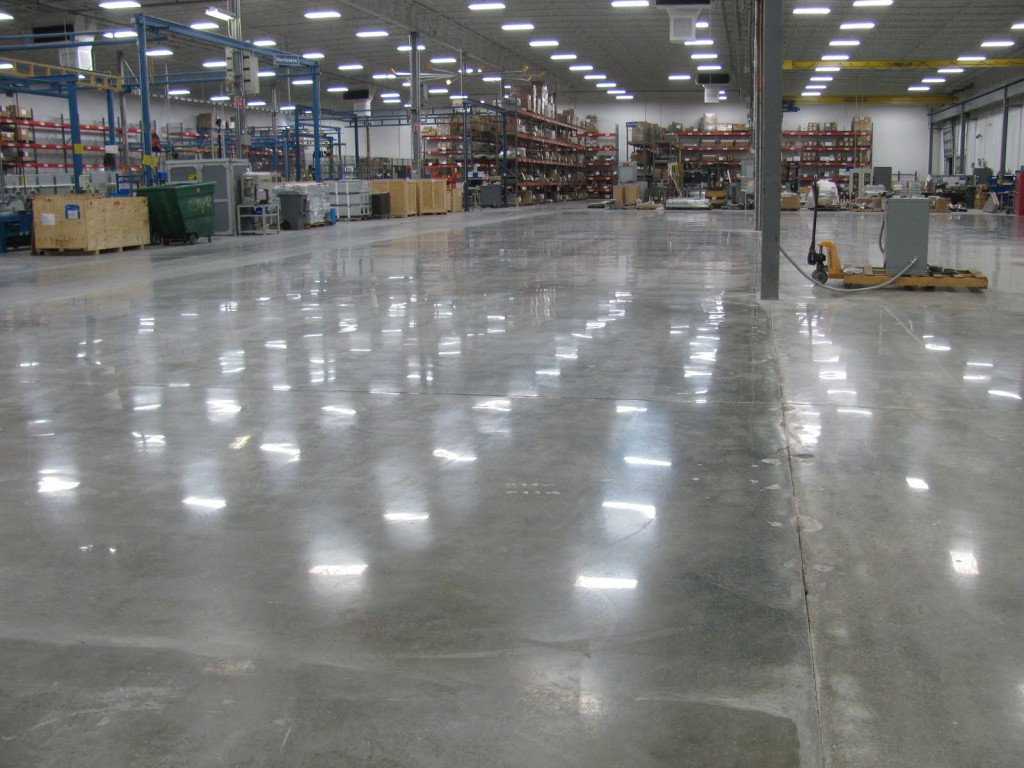Knoxville Concrete Polishing
Serving Tennessee & The Nation

Simply put, polishing concrete is similar to sanding wood. Heavy-duty polishing machines equipped with progressively finer grits of diamond-impregnated segments or disks (akin to sandpaper) are used to gradually grind down surfaces to the desired degree of shine and smoothness.
The process begins with the use of coarse diamond segments bonded in a metallic matrix. These segments are coarse enough to remove minor pits, blemishes, stains, or light coatings from the floor in preparation for final smoothing. Depending on the condition of the concrete, this initial rough grinding is generally a three- to four-step process.
The next steps involve fine grinding of the concrete surface using diamond abrasives embedded in a plastic or resin matrix. Crews use ever-finer grits of polishing disks (a process called lapping) until the floor has the desired sheen. For an extremely high-gloss finish, a final grit of 1500 or finer may be used. Experienced polishing crews know when to switch to the next-finer grit by observing the floor surface and the amount of material being removed.
During the polishing process an internal impregnating sealer is applied. The sealer sinks into the concrete and is invisible to the naked eye. It not only protects the concrete from the inside out, it also hardens and densifies the concrete. This eliminates the need for a topical coating, which reduces maintenance significantly (versus if you had a coating on it). Some contractors spread a commercial polishing compound onto the surface during the final polishing step, to give the floor a bit more sheen. These compounds also help clean any residue remaining on the surface from the polishing process and leave a dirt-resistant finish.
You can polish concrete using wet or dry methods. Although each has its advantages, dry polishing is the method most commonly used in the industry today because it’s faster, more convenient, and environmentally friendly. Wet polishing uses water to cool the diamond abrasives and eliminate grinding dust. Because the water reduces friction and acts as a lubricant, it increases the life of the polishing abrasives. The chief disadvantage of this method is the cleanup. Wet polishing creates a tremendous amount of slurry that crews must collect and dispose of in an environmentally sound manner. With dry polishing, no water is required. Instead, the floor polisher is hooked up to a dust-containment system that vacuums up virtually all of the mess.
Many contractors use a combination of both the wet and dry polishing methods. Typically, dry polishing is used for the initial grinding steps, when more concrete is being removed. As the surface becomes smoother, and crews switch from the metal-bonded to the finer resin-bonded diamond abrasives, they generally change to wet polishing.
Polishing brings out the natural beauty of concrete by smoothing the surface. Through multiple grinding stages, we will smooth your concrete to an even and pristine state. From there, we can apply an optional dye, then the hardener. Finally, we make the last grinding pass that brings out the luster.
Some advantages of Concrete Polishing include:
- Increase Slip Resistance
- Superior Durability
- Cost-Effectiveness
- Low-Maintenance
- Stain-Resistance
- Improved Reflectivity of Ambient Lighting
- Eliminates Dusting Caused by Efflorescence
- Non-Combustibility
- Reduced Tire Wear
- Customizable Look (Can be stained or stenciled.)
Contact A Concrete Polishing Contractor Today!
Contact Knoxkrete today for a FREE estimate. We can handle any commercial, industrial, or residential job. We are a family owned and operated business and we guarantee all of our work.
